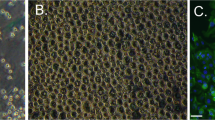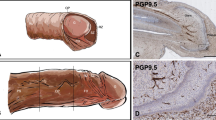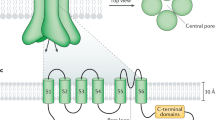Abstract
The transient receptor potential cationic channel ankyrin 1 (TRPA1) is a channel protein assumed to act in various human tissues as mechano- and pain sensor and play a role in neurotransmission. The expression of TRPA has already been investigated in the human prostate and urethra, however, only very few studies have addressed the expression and distribution in the male and female genital tract. The present study aimed to investigate by means of immunohistochemistry (double-labeling technique, laser fluorescence microscopy) in the human clitoris and penile erectile tissue the localization of TRPA1 in relation to nNOS, the vasoactive intestinal polypeptide (VIP) and vesicular acetylcholine transporter (VAChT). In the clitoral tissue, TRPA1 was observed in basal epithelial cells and slender nNOS-positive nerve fibers transversing the subepithelial space. To a certain degree, in the clitoral epithelial cells, TRPA1 was found co-localized with vimentin. In human corpus cavernosum, immunoreactivity for TRPA1 was seen in nerves transversing the cavernous sinusoidal space and running alongside small arteries, these nerves also displayed expression of the vesicular acetylcholine transporter protein (VAChT). Varicose nerves containing nNOS or VIP were not immunoreactive for TRPA1. It seems likely that TRPA1 is involved in nitric oxide-mediated afferent sensory transmission in the clitoris while, in penile erectile tissue, a role for TRPA1 in cholinergic signaling might be assumed.
This is a preview of subscription content, access via your institution
Access options
Subscribe to this journal
Receive 8 print issues and online access
$259.00 per year
only $32.38 per issue
Buy this article
- Purchase on Springer Link
- Instant access to full article PDF
Prices may be subject to local taxes which are calculated during checkout



Similar content being viewed by others
References
Fisher S, Osofsky H . Sexual responsiveness in women. Psychological correlates. Arch Gen Psychiatry 1967; 17: 214–226.
Munarriz R, Kim NN, Goldstein I, Traish AM . Biology of female sexual function. Urol Clin North Am 2002; 29: 685–693.
Martin-Alguacil N, Pfaff DW, Shelley DN, Schober JM . Clitoral sexual arousal: an immunocytochemical and innervation study of the clitoris. BJU Int 2008; 101: 1407–1413.
Tarcan T, Park K, Goldstein I, Maio G, Fassina A, Krane RJ et al. Histomorphometric analysis of age-related structural changes in human clitoral cavernosum tissue. J Urol 1999; 161: 940–944.
Du S, Araki I, Kobayashi H, Zakoji H, Sawada N, Takeda M . Differential expression profile of cold (TRPA1) and cool (TRPM8) receptors in human urogenital organs. Urology 2008; 72: 450–455.
Gratzke C, Streng T, Waldkirch E, Sigl K, Stief C, Andersson KE et al. Transient receptor potential A1 (TRPA1) activity in the human urethra - evidence for a functional role for TRPA1 in the outflow region. Eur Urol 2009; 55: 696–704.
Gratzke C, Weinhold P, Reich O, Seitz M, Schlenker B, Stief CG et al. Transient receptor potential A1 and cannabinoid receptor activity in human normal and hyperplastic prostate: relation to nerves and interstitial cells. Eur Urol 2010; 57: 902–909.
Di A, Malik AB . TRP channels and the control of vascular function. Curr Opin Pharmacol 2010; 10: 127–132.
Fernandes VS, Ribeiro AS, Barahona MV, Orensanz LM, Martínez-Sáenz A, Recio P . Hydrogen sulfide mediated inhibitory neurotransmission to the pig bladder neck: role of KATP channels, sensory nerves and calcium signaling. J Urol 2013; 190: 746–756.
Venkatachalam K, Montell C . TRP channels. Annu Rev Biochem 2007; 76: 387–417.
Ückert S, Sonnenberg JE, Albrecht K, Kuczyk MA, Hedlund P . Expression and distribution of the transient receptor potential cationic channel ankyrin 1 (TRPA1) in the human vagina. Int J Impot Res 2015; 27: 16–19.
Ückert S, Simon A, Sonnenberg JE, Merseburger AS, Kuczyk MA, Hedlund P . Expression of the transient receptor potential cationic channel A1 (TRPA1) in the human seminal vesicles - an immunohistochemical and molecular biology study. Eur Urol Suppl 2013; 12 (No 1): e329 (abstract, presented at the 28th Congressof the European Association of Urology, Milano, Italy, 15–19 March 2013).
Berman JR, Bassuk J . Physiology and pathophysiology of female sexual function and dysfunction. World J Urol 2002; 20: 111–118.
Hicks GA . TRP channels as therapeutic targets: hot property, or time to cool down? Neurogastroenterol Motil 2006; 18: 590–594.
Andersson KE, Gratzke C, Hedlund P . The role of the transient receptor potential (TRP) superfamily of cation-selective channels in the management of the overactive bladder. BJU Int 2010; 106: 1114–1127.
Streng T, Axelsson HE, Hedlund P, Andersson DA, Jordt SE, Bevan S et al. Distribution and function of the hydrogen sulfide-sensitive TRPA1 ion channel in rat urinary bladder. Eur Urol 2008; 53: 391–399.
Weinhold P, Gratzke C, Streng T, Stief CG, Andersson KE, Hedlund P . TRPA1 receptor induced relaxation of the human urethra involves TRPV1 and cannabinoid receptor mediated signals, and cyclooxygenase activation. J Urol 2010; 183: 2070–2076.
Kostin S, Popescu LM . A distinct type of cell in myocardium: interstitial Cajal-like cells. J Cell Mol Med 2009; 13: 295–308.
Sui GP, Rothery S, Dupont E, Fry CH, Severs NJ . Gap junctions and connexin expression in human suburothelial interstitial cells. BJU Int 2002; 90: 118–129.
Shafik A . Study of interstitial cells in the penis: human study. J Sex Med 2007; 4: 66–71.
García-Pascual A, Sancho M, Costa G, Triguero D . Interstitial cells of Cajal in the urethra are cGMP-mediated targets of nitrergic neurotransmission. Am J Physiol Renal Physiol 2008; 295: F971–F983.
Collins C, Klausner AP, Herrick B, Koo HP, Miner AS, Henderson SC et al. Potential for control of detrusor smooth muscle spontaneous rhythmic contraction by cyclooxygenase products released by interstitial cells of Cajal. J Cell Mol Med 2009; 13: 3236–3250.
Ückert S, Oelke M, Albrecht K, Breitmeier D, Kuczyk MA, Hedlund P . Expression and distribution of key enzymes of the cyclic GMP signaling in the human clitoris: relation to phosphodiesterase type 5 (PDE5). Int J Impot Res 2011; 23: 206–212.
Traish A, Kim N . The physiological role of androgens in penile erection: regulation of corpus cavernosum structure and function. J Sex Med 2005; 2: 759–770.
Shen ZJ, Zhou XL, Lu YL, Chen ZD . Effect of androgen deprivation on penile ultrastructure. Asian J Androl 2003; 5: 33–36.
Becker AJ, Ückert S, Stief CG, Truss MC, Machtens S, Scheller F et al. Possible role of human growth hormone in penile erection. J Urol 2000; 164: 2138–2142.
Ückert S, Ellinghaus P, Albrecht K, Jonas U, Oelke M . Expression of messenger ribonucleic acid encoding for phosphodiesterase isoenzymes in human female genital tissues. J Sex Med 2007; 4: 1604–1609.
Author information
Authors and Affiliations
Corresponding author
Ethics declarations
Competing interests
The authors declare no conflict of interest.
Rights and permissions
About this article
Cite this article
Ückert, S., Albrecht, K., Bannowsky, A. et al. Expression and distribution of the transient receptor potential cationic channel A1 (TRPA1) in the human clitoris—comparison to male penile erectile tissue. Int J Impot Res 29, 179–183 (2017). https://doi.org/10.1038/ijir.2017.15
Received:
Revised:
Accepted:
Published:
Issue Date:
DOI: https://doi.org/10.1038/ijir.2017.15
This article is cited by
-
Exploration of Ion Channels in the Clitoris: a Review
Current Sexual Health Reports (2019)



